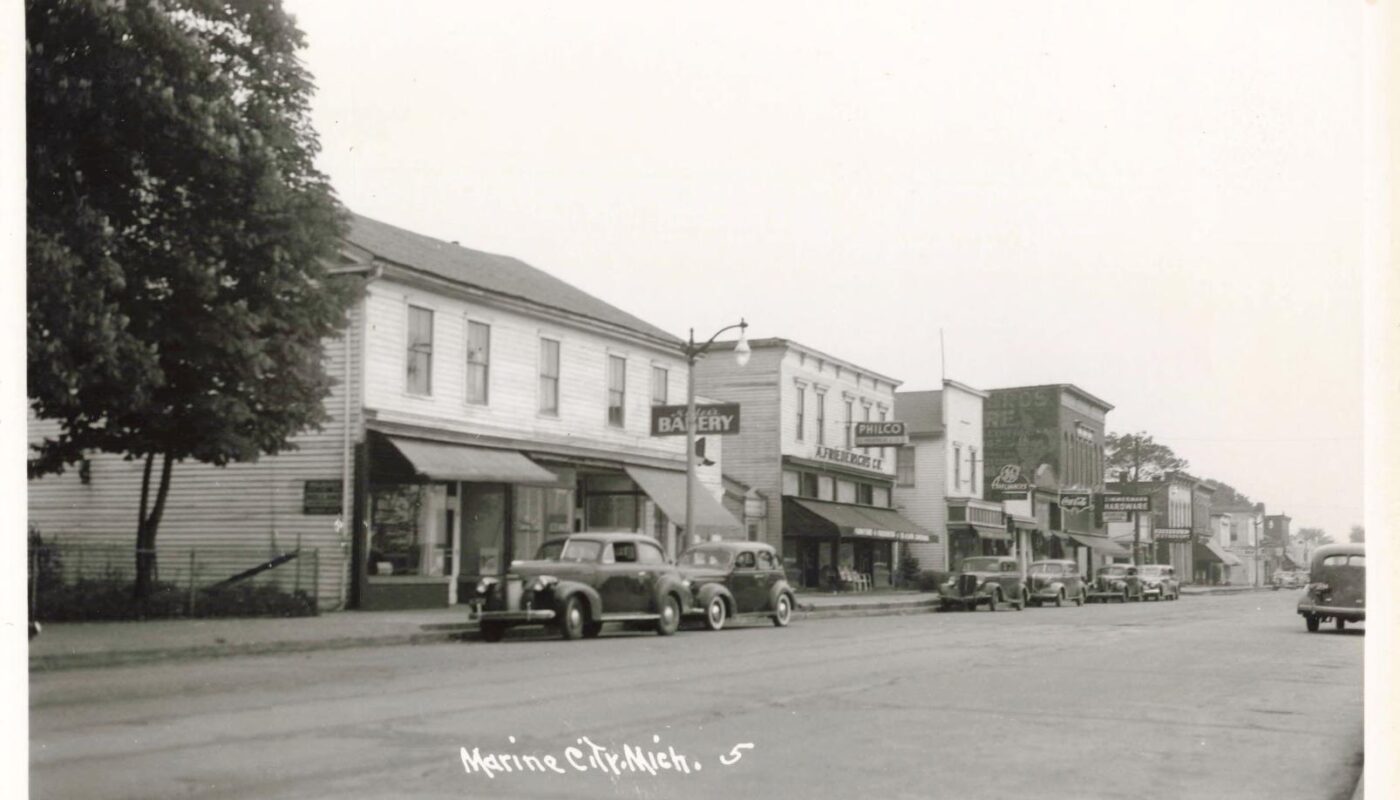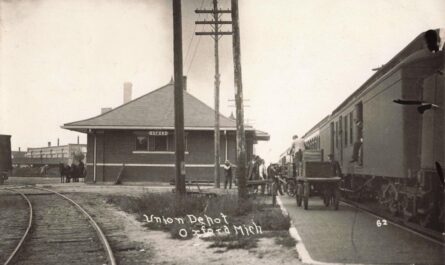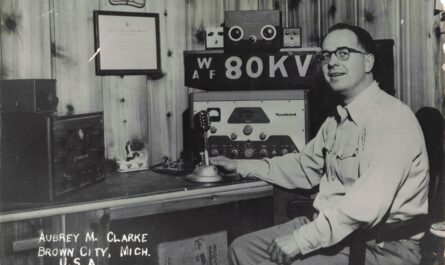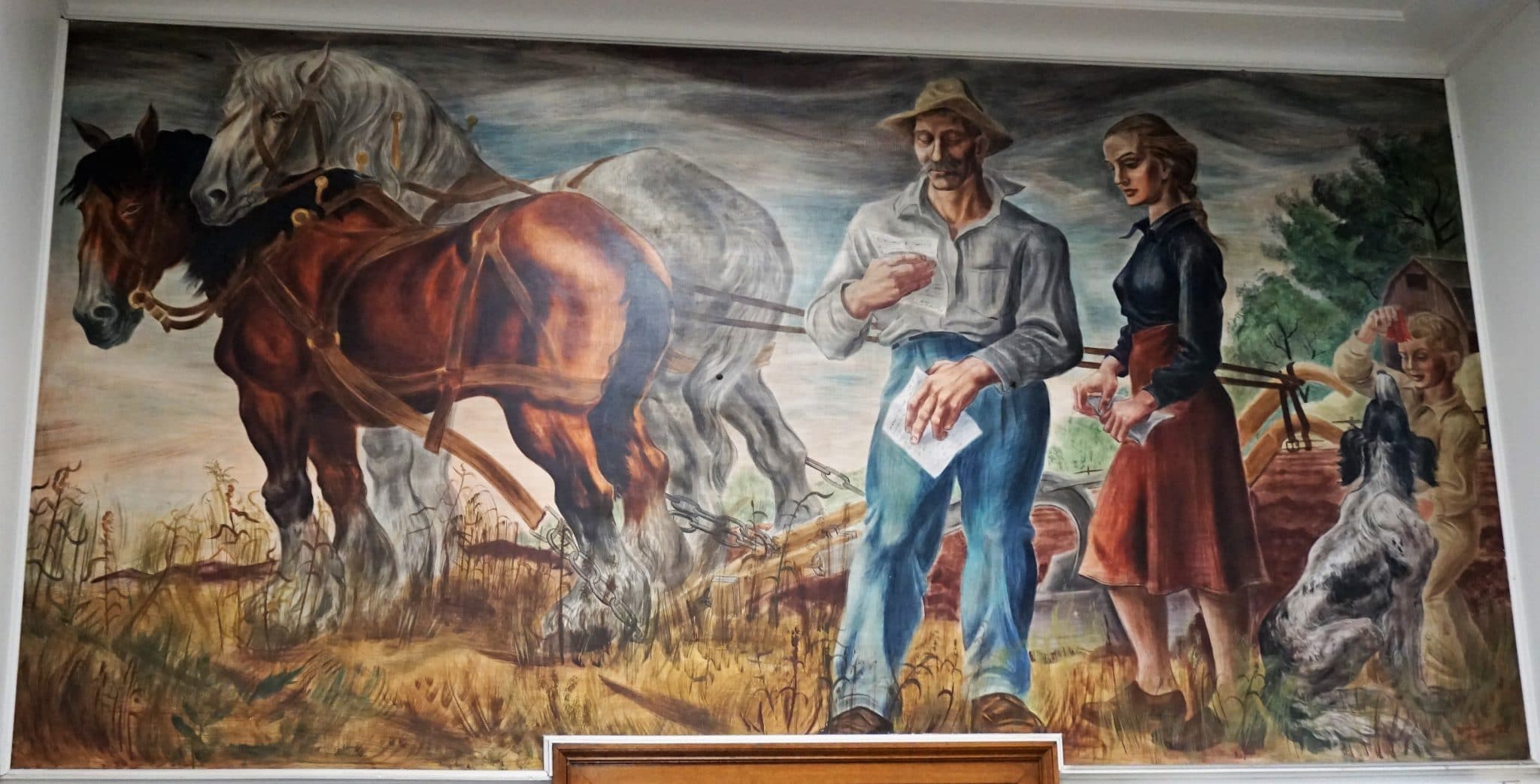Marine City, Michigan, once stood as one of the busiest shipbuilding towns on the Great Lakes. Its workers built schooners, barges, and steamers that kept the lakes moving. Following a major salt discovery in 1882, the town expanded with the addition of salt works and a sugar beet refinery, creating even more job opportunities. Take a look at the history of Marine City with vintage photos and see how this river town grew between 1880 and 1950.
Table of Contents
Video – Marine City: Between Rivers and Industry
River traffic at dawn. Muddy streets. Hotel bath houses. Marine City’s early 1900s was full of hustle. Learn what built this town — and what remains today.
A Boomtown on the St. Clair River
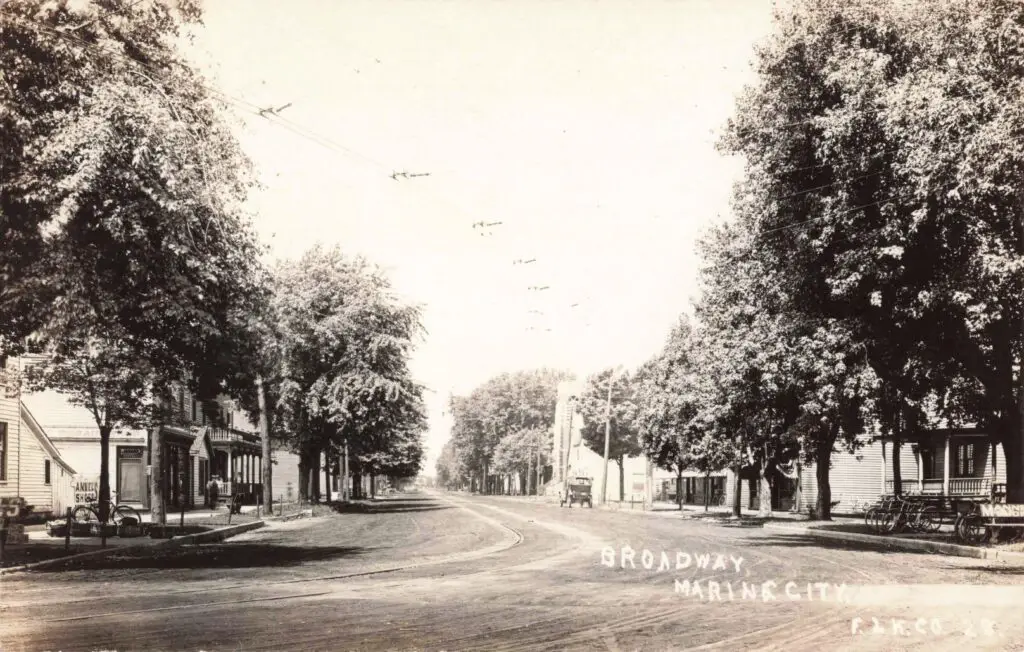
Marine City, Michigan – once known as Newport – emerged in the 19th century as a bustling shipbuilding center on the St. Clair River. The town was formally platted as “Newport” in 1835 by Samuel Ward, and later incorporated as the Village of Marine City in 1865. After rapid growth driven by lumber and maritime trade, Marine City reincorporated as a city in 1887. Throughout the late 1800s and early 1900s, Marine City’s economy boomed on Great Lakes shipping and a cluster of local industries. By the turn of the 20th century, it was famed as one of the Great Lakes’ major shipbuilding towns. The population included many French-Canadian and other immigrant families, giving the town a culturally diverse, tight-knit character rooted in maritime life and Catholic faith. This period (circa 1880–1950) saw Marine City at its industrial peak, followed by transitions as those industries changed or faded after World War II.
Industries That Shaped Marine City’s Growth
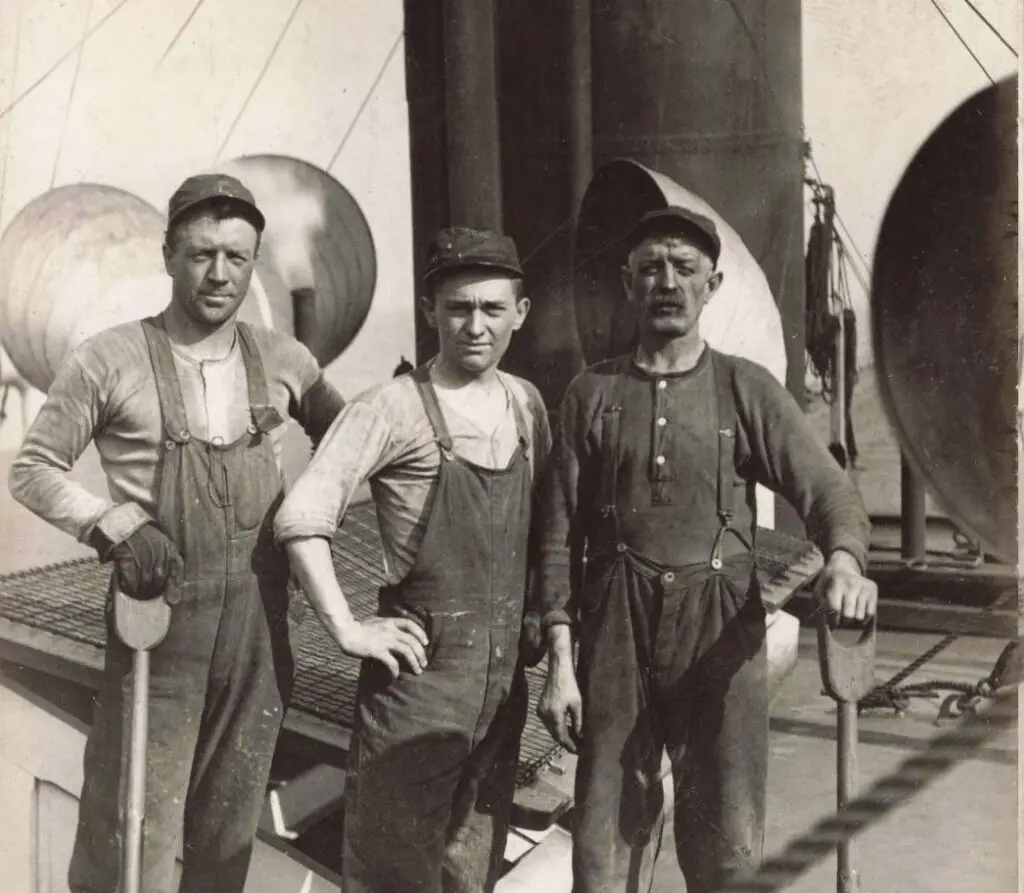
Multiple industries fueled prosperity in Marine City between the late 1800s and 1950. The most prominent included shipbuilding, lumber and logging, barrel manufacturing, salt production, sugar refining, and grain milling:
Marine City Michigan Shipbuilding Industry
Wooden shipbuilding was the backbone of Marine City’s economy in the 19th century. The town (then called Newport) became especially noted for constructing Great Lakes vessels, outpacing even larger cities in ship output. Local shipyards launched schooners, steam barges, and freighters that carried lumber, grain, and passengers through the Great Lakes. Notable shipwrights like Jacob L. Wolverton (who built the steamer Antelope in 1861) and later Matthew S. Sicken upheld Marine City’s reputation for quality shipbuilding. This industry thrived into the early 20th century – Marine City remained a wooden shipbuilding center until the 1920s – providing jobs for carpenters, ship engineers, and sailors across generations.
Marine City Michigan Lumber and Timber Economy
The surrounding region’s timber fueled both the shipyards and a lucrative lumber trade. In the mid-1800s, logs harvested in Michigan’s Thumb were rafted downriver to mills; Marine City profited as a transit point for this lumber flow. Many wooden ships built here even transported lumber cargoes. By the 1870s the old-growth timber waned, but lumber had already made fortunes for local entrepreneurs. The timber boom left behind sawmills and skilled woodworkers who transitioned into other trades like boatbuilding and barrel-making.
Marine City Michigan Barrel and Stave Manufacturing
Marine City became a barrel stave manufacturing hub after the Civil War. The Marine City Stave Company (founded 1874) turned out 12–15 million oak staves annually for flour and sugar barrels, plus half a million barrel heads, making it one of the town’s largest employers. This industry went hand-in-hand with logging, since coopers and mill workers used local wood to supply barrels for shipping goods. The stave company’s success also accidentally led to another industry – salt – when it drilled a deep well seeking fresh water.
Marine City Michigan Salt Industry and 1882 Discovery
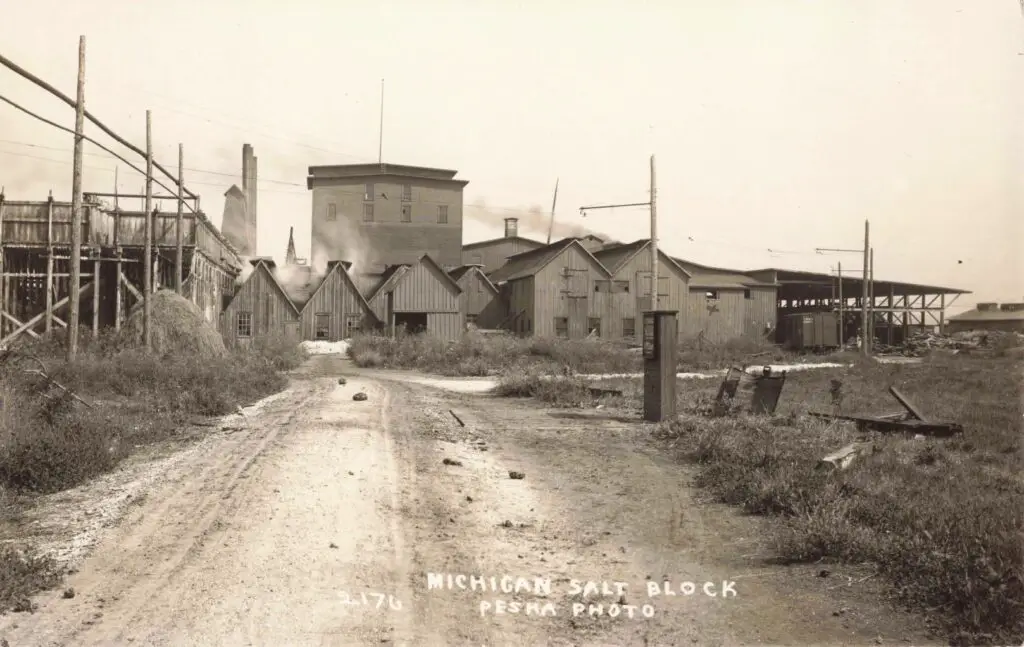
In 1882, a well drilled on the Marine City Stave Co. property struck a massive deposit of rock salt about 1,700 feet underground. Crockett McElroy, president of the stave company, is credited with this discovery and proving the salt bed’s value. Soon a Marine City Salt Works was established to extract brine, making the town one of 13 salt-producing locales in St. Clair County by 1910. Salt blocks and brine evaporation became an important local business in the late 19th century, capitalizing on the “white gold” beneath Marine City’s soil. (A small industrial locomotive at the salt works, shown below, was used to haul salt and materials.)
Marine City Michigan Sugar Beet Refining Industry
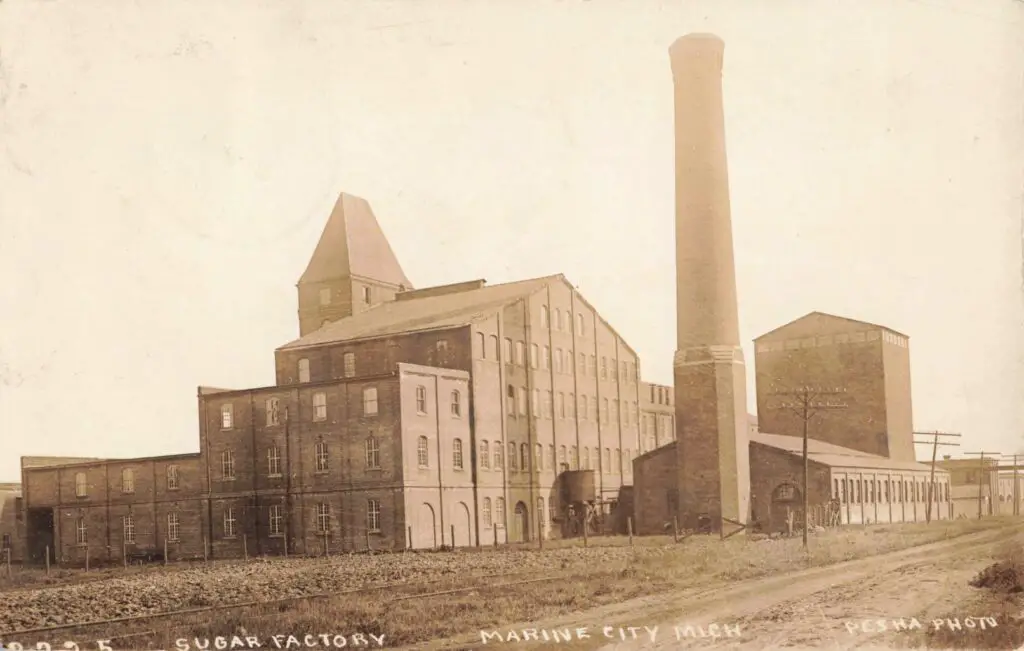
Around 1900, Marine City citizens courted investors to build a beet sugar refinery, aiming to join Michigan’s sugar boom. The Marine City Sugar Company opened a modern beet sugar factory in 1901. Initially backed by financiers from Cleveland, it processed sugar beets from local farms into refined sugar. Though state-of-the-art, the venture faced challenges – unruly seasonal labor (former lumberjacks) and volatile sugar prices. After a series of management changes, the plant (later called Independent Sugar Co.) shut down by 1913. Briefly reopened during World War I, it closed for good by the 1920s as the industry consolidated. The imposing brick refinery (pictured below) was a source of pride while it operated, symbolizing an era of agricultural industry that was short-lived in Marine City. The Independence Sugar Co. factory in Marine City, c.1905, which refined locally grown sugar beets. Though technologically advanced, the sugar refinery operated only intermittently from 1901 to 1913.
Marine City Michigan Grain Mills and Elevators
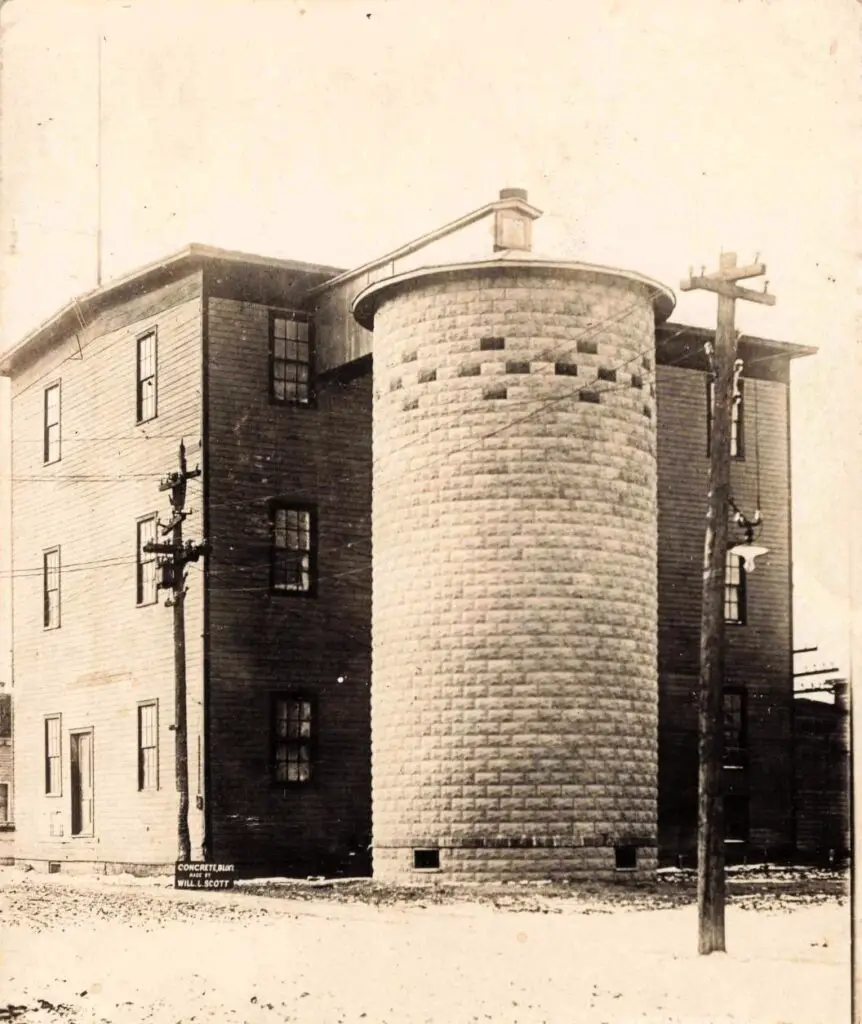
The fertile farmland of St. Clair County also supported grain farming, and Marine City had grain mills to process wheat and other crops. The Marine City Roller Mills company ran a large flour mill and built a notable grain elevator by the river for storage and export. Uniquely, the 65-foot grain elevator constructed in the early 1900s used innovative waterproof concrete blocks invented by local builder Will J. Scott. This concrete block elevator was touted in farming journals as a modern design (the same block style was used in silo construction nationwide). The grain trade through Marine City’s elevators allowed local farmers to ship their harvests via Great Lakes freighters.
Together, these industries made Marine City a classic Gilded Age boomtown. In the late 1800s the waterfront bustled with wooden ship hulls under construction, piles of lumber and barrel staves, the haze of salt boiling vats, and the towering grain elevator silos. Industrial growth also spurred supporting businesses – from brickyards and block-makers to machine shops – and drew in immigrant labor (Polish, German, Belgian and others) who enriched the community’s cultural fabric.
Daily Life in Marine City around 1900
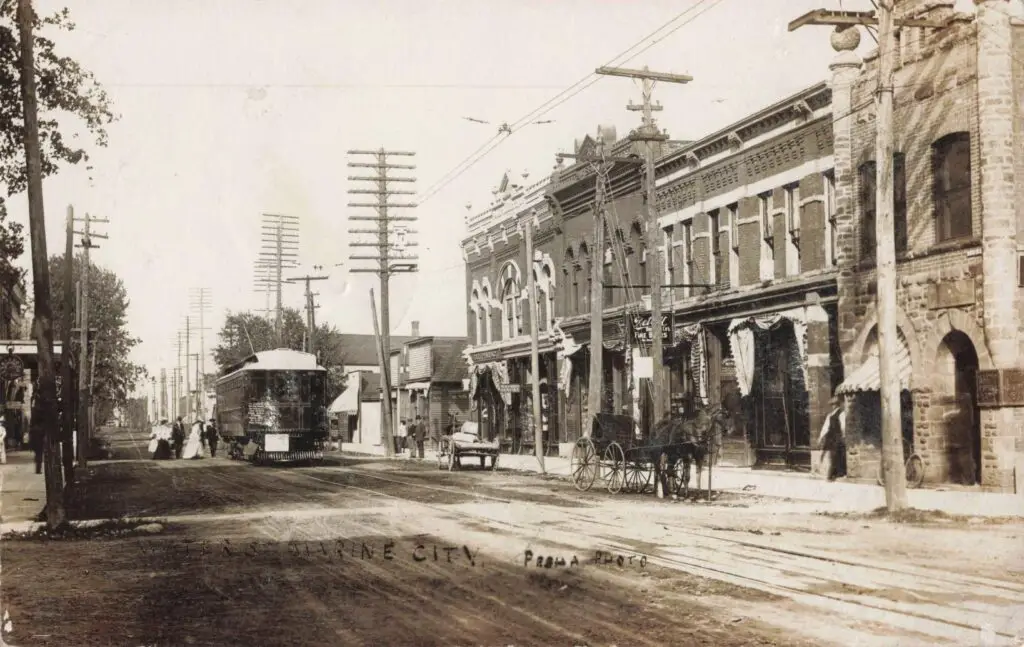
Life in Marine City during its industrial heyday blended hard work with close-knit community living. Residents generally enjoyed a modest but comfortable lifestyle by the standards of the era. A snapshot of daily life in the late 19th and early 20th centuries includes:
Housing and Neighborhoods in Marine City Michigan
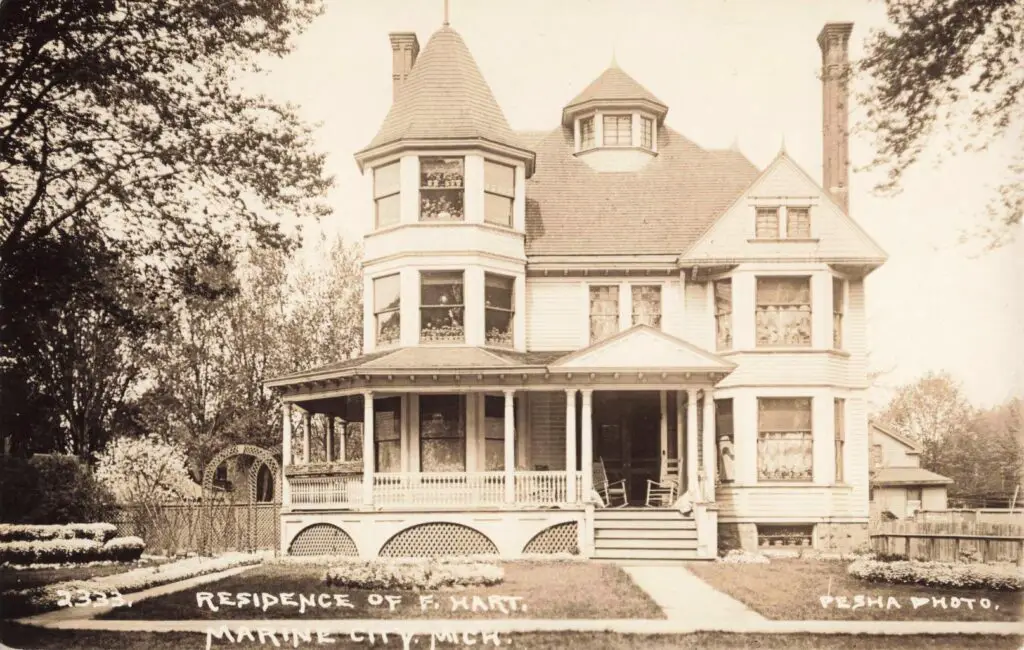
Many families lived in wood-frame Victorian homes, reflecting the prosperity of the era. The city’s architectural charm was notable – Marine City was “unusually rich in Victorian architecture,” with ornate porches and gables decorating even modest houses. Homes were often built by local craftsmen (ship carpenters turned house builders), and neighborhoods were dotted with picket fences, flower gardens, and the occasional carriage house or barn out back for horses.
Marine City Michigan Interurban Rail and Transportation
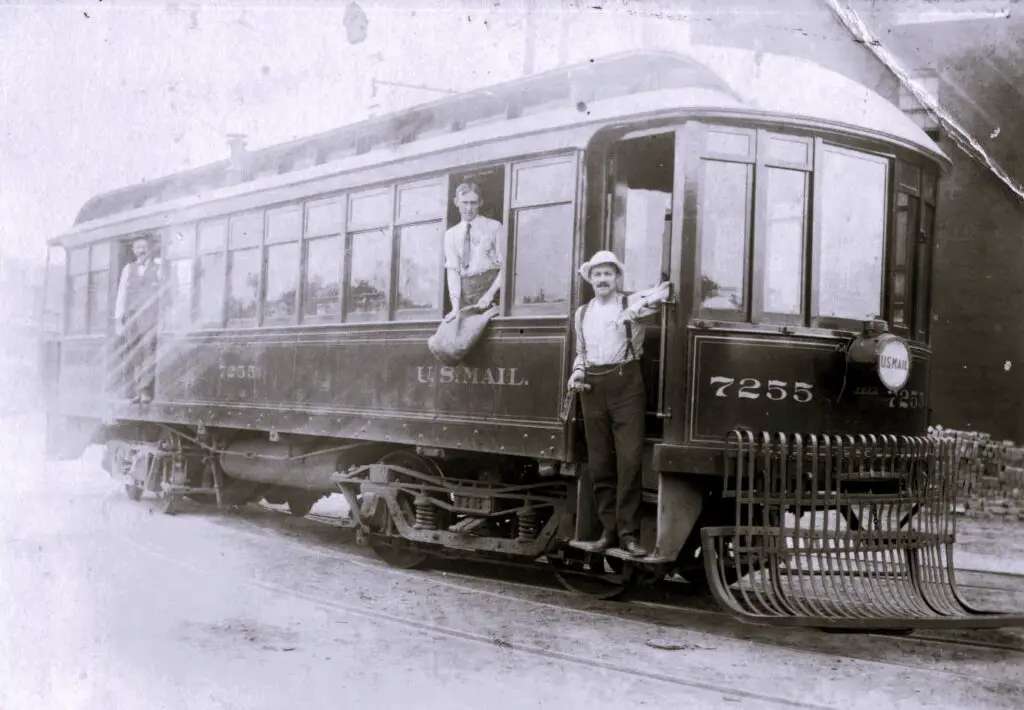
In the 1890s–1910s, Marine City was well-connected despite its small size. An electric interurban railway ran down Main Street, linking Marine City to Detroit and Port Huron by 1900. Residents or visitors could hop a trolley-style interurban car outside the Hotel DuPont downtown and ride to big-city destinations in an era before highways. Horse-drawn vehicles remained common for local travel, gradually giving way to automobiles by the 1920s. On the river, passenger steamers and ferryboats were regular sights – at one time dozens of steamship lines stopped at river towns like Marine City, carrying both travelers and day-trippers. Many locals also worked on freighters and would be away during the shipping season, as hundreds of Marine City’s men served as Great Lakes sailors each year.
Downtown Businesses in Marine City Michigan
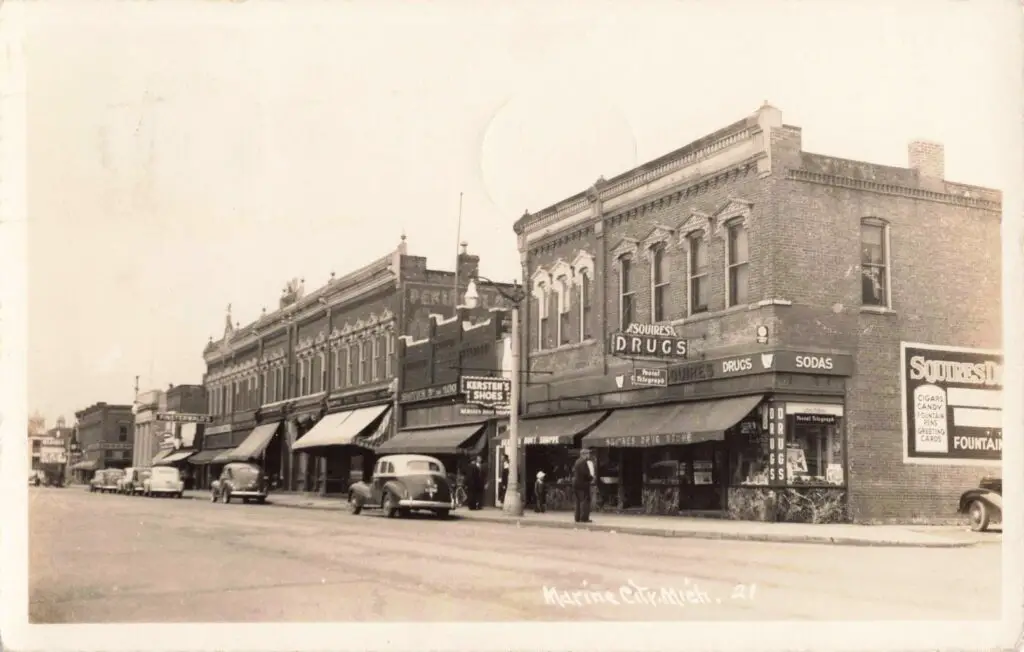
Marine City’s downtown (along Water Street and Broadway) was a bustling commercial district. There were dry goods stores, grocers, butcher shops, hardware stores like the Scott Brothers Hardware, pharmacies, and taverns catering to residents and sailors alike. The Scott Brothers, in particular, were a prominent business family – aside from running the hardware and building supply store, Will J. Scott’s concrete block enterprise contributed to local construction (as seen in the grain elevator). Many businesses were family-owned and passed down generations. A local newspaper kept citizens informed, and several banks financed ventures from shipbuilding to house mortgages. The city’s waterfront featured grain elevator docks and a ferry landing, where farmers and merchants converged on market days.
Marine City Michigan Holy Cross Church and Schools
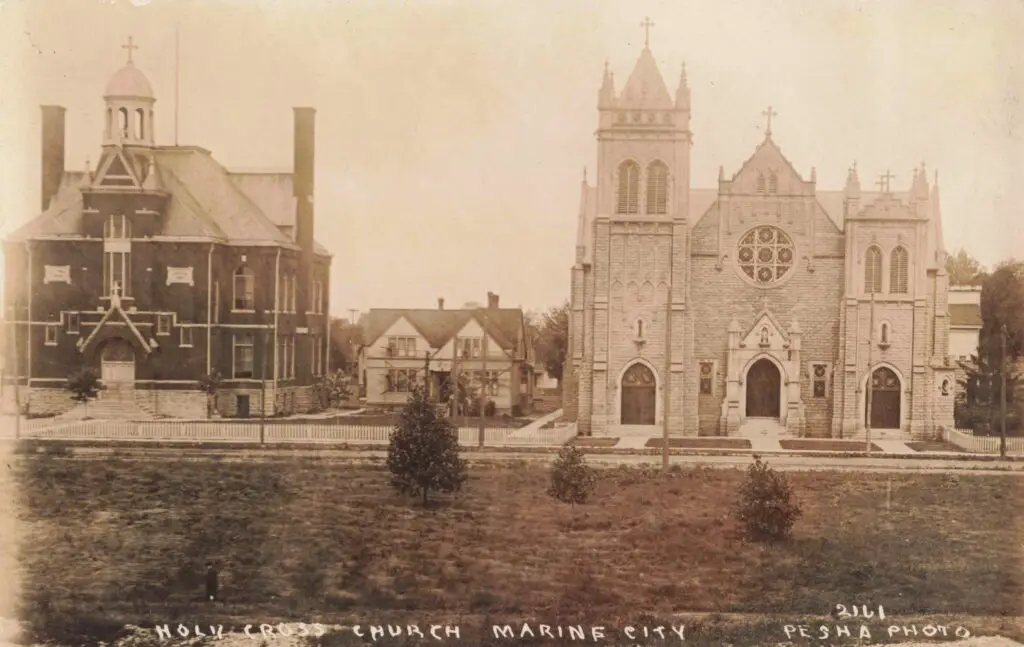
Social life often centered on church and school events. Holy Cross Catholic Church, built of limestone in 1903, was (and remains) a landmark on South Water Street. It served a predominantly Catholic populace, including Irish, German, and Polish families; its adjacent parish school (Holy Cross School, founded 1869) educated local children. Other denominations had churches as well, and public schools provided education through high school by the early 20th century. Churches frequently hosted fairs, dances, and charitable events that brought the whole town together.
Marine City Michigan Leisure and Community Life
In an age before TV and internet, Marine City made its own fun. The town had an Opera House (a public hall, often the second floor of City Hall or a dedicated venue) which hosted traveling theater troupes, vaudeville shows, boxing matches, and lectures – reliably drawing big crowds on weekends. Silent motion pictures later flickered in local theaters by the 1910s. Seasonal events were popular: in summer, residents enjoyed swimming, fishing, and riverside picnics while watching lake freighters glide by. There were reported regattas and boat parades on the river. In winter, ice skating on the frozen river or sledding were common pastimes. Civic organizations (Masons, Odd Fellows, and a mariners’ lodge) provided social networking for adults. All told, daily life balanced work and recreation, with the ever-present river fostering a maritime culture – locals often strolled the docks to see which steamers were in port and swapped news of Great Lakes happenings.
Notable Figures and Families in the Community

Marine City’s story was shaped not only by industries but by enterprising individuals and families. Some of the noteworthy figures from the late 1800s through 1950 include:
Samuel Ward & Family
A founding figure, Sam Ward platted “Newport” (Marine City) in 1835. His nephew Eber Brock Ward worked here as a young man in the 1830s; E.B. Ward went on to become a Great Lakes shipping magnate and steel industry pioneer, though he is better known in Detroit. The Ward family’s early investments helped establish Marine City’s shipyards and docks, setting the stage for its maritime economy.
Crockett McElroy
A key industrialist, Crockett McElroy was president of the Marine City Stave Company. He spearheaded the 1882 salt well drilling and thus “deserves all the credit” for discovering the deep salt deposits under Marine City. McElroy’s initiative gave rise to the Marine City Salt Works and added a new pillar to the local economy. The McElroy family remained influential in business and civic affairs into the early 20th century.
The Scott Brothers
William “Will” J. Scott and family left a lasting imprint through their hardware and construction business. Will J. Scott developed waterproof concrete building blocks and used them to construct the large grain elevator for Marine City Roller Mills around 1900. The Scott Brothers Hardware store became a longstanding institution downtown (later evolving into Scott’s Pharmacy mid-century). Their entrepreneurial spirit in materials technology and retail made the Scott name well known locally.
Jacob Wolverton & Matthew S. Sicken
These men exemplify Marine City’s master shipbuilders. Jacob L. Wolverton ran a shipyard in the 1850s–60s, building vessels like the packet steamer Antelope (launched 1861 at Newport) that served Great Lakes routes. Matthew S. Sicken was a late-era shipbuilder who notably constructed Holy Cross Church in 1903, utilizing his ship carpentry expertise. Sicken’s dual legacy (launching ships and raising a stone church) captures the versatile craftsmanship found in Marine City.
Louis James Pesha
Though not an industrialist, L. J. Pesha was a prolific Marine City photographer whose work became famous. In the early 1900s, Pesha’s studio on Water Street captured thousands of glass-plate photos of passing ships and local scenes. After his untimely death in 1912, his wife Lena continued the studio. Pesha’s photographs (many now archived in museums) have preserved Marine City’s maritime heritage – including an extraordinary image of an outdoor temperature display next to Holy Cross Church that gave passing ship captains a weather report, a novelty of the era. The Pesha family’s contribution to documenting daily life makes them part of local lore.
William Sauber
A prominent citizen in both marine and civic spheres, William H. Sauber was a German immigrant who settled in Marine City in the 1870s. He served as a chief engineer on Great Lakes steamers and invested in vessels, exemplifying the town’s “lake-faring” men. Sauber later became a director of the Marine City Sugar Company and even the Mayor of Marine City in 1900. His story reflects how maritime careers often dovetailed with local business and politics.
Additionally, numerous local families, including the Wards, McElroys, Scotts, and others, intermarried and held prominent roles as businessmen, civic leaders, and philanthropists. Their names pepper old newspapers as aldermen, school board members, church benefactors, and festival organizers. Marine City’s community was small enough that a dedicated individual could have an outsized impact, and these figures did just that.
Landmarks and Sites of the Era
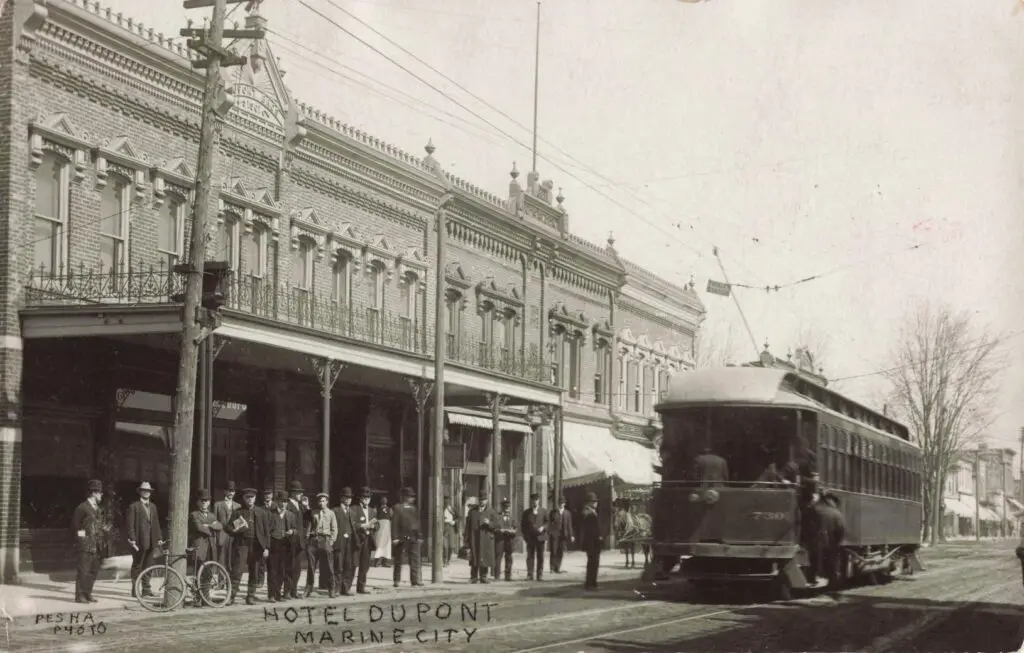
The physical landscape of Marine City between 1880 and 1950 featured distinctive buildings and sites, many of which survive (in some form) today:
City Hall (Heritage Square)
Built in 1884–85, Marine City’s red-brick City Hall stands as a proud emblem of the booming 1880s. Designed by famed Detroit architects Mason & Rice, the building is a two-story Queen Anne-style structure with a bell-tower cupola and an attached 1910 fire hall. Its second-floor auditorium served as the community’s meeting hall and opera house for decades. City Hall was added to the National Register of Historic Places in 1982, recognized for its architectural significance and role in local government. Today, the building anchors “Heritage Square,” a small park area with historic markers, and it continues to be used for city offices and events, symbolizing Marine City’s preserved heritage.
Holy Cross Church and School
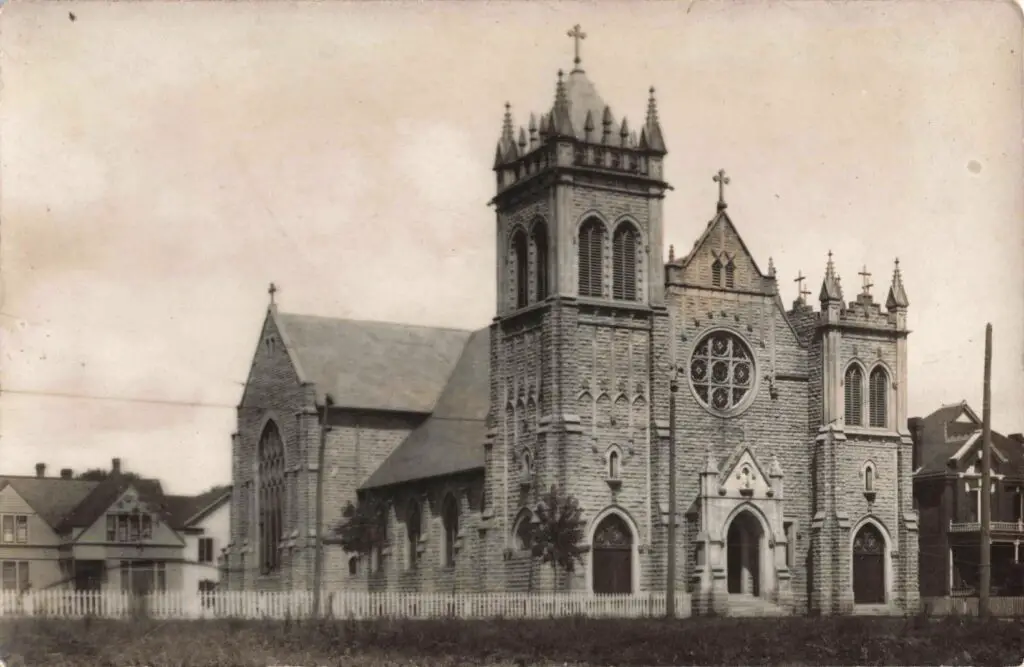
The Holy Cross Catholic Church, completed in 1903, is a Gothic-style stone church with twin towers visible from the river. It was the second church on its site (replacing an 1860s structure) and was built by shipbuilder Matthew Sicken, giving it superior craftsmanship. Holy Cross became the spiritual and social heart of Marine City’s Catholic community. Next door, the parish school (founded in 1869) educated generations of children. Both buildings still stand on Holy Cross Boulevard: the church remains an active worship site and part of Our Lady on the River parish, while the old school has evolved but the legacy continues in local Catholic education. Holy Cross Church, with its stained glass and antique bell cast in Normandy, France, is not only an architectural landmark but also a direct link to Marine City’s 19th-century “Catholic Pointe” settlement.
Downtown Hotels (DuPont & Colonial)
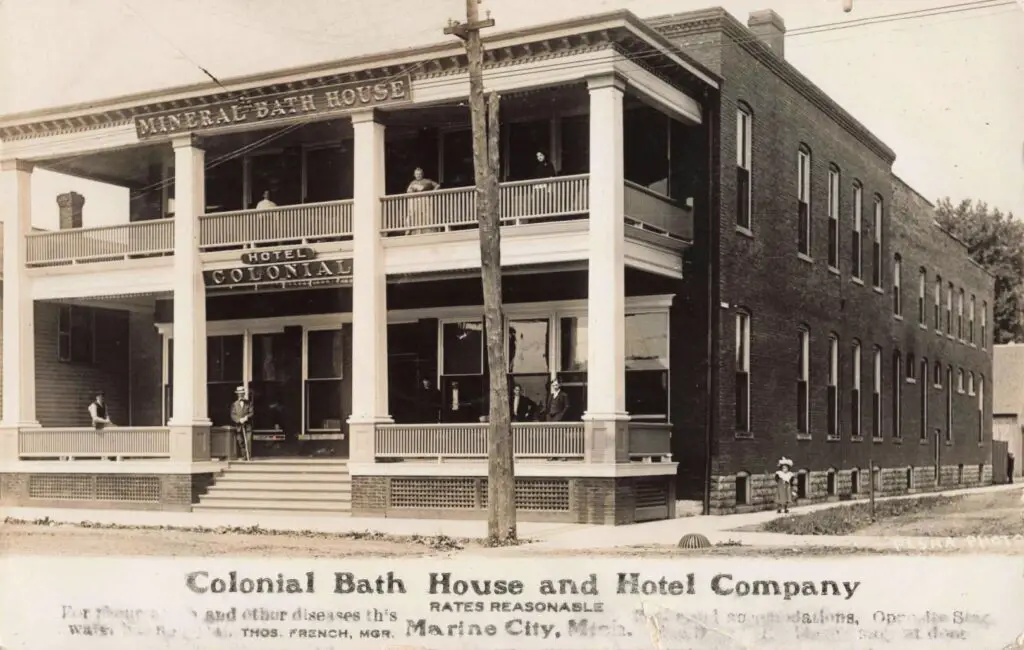
During the early 1900s, Marine City boasted several hotels that served travelers and businessmen. The Hotel DuPont, located on Broadway (Water St.) at Fifth, was a grand three-story brick hotel with a distinctive corner turret. It was a popular stop for interurban rail passengers – the trolley line ran right past it. By the 1920s, this establishment was known as the Hotel Marine City or later the Hotel Colonial. Period postcards from 1909 depict the Colonial Hotel and Bath House, indicating that one hotel offered not only lodging but also spa-like “baths” (possibly capitalizing on the era’s interest in mineral bath resorts). The Hotel Colonial at 5th and Water streets continued in operation into the 1940s. These hotels were centers of social activity – hosting banquets, receptions, and housing visitors for the town’s many regattas and events. While they no longer operate as hotels today, the historic buildings remain part of Marine City’s streetscape, with one renovated into apartments and shops.
Downtown Marine City in the early 1900s, showing the Hotel DuPont (right) and an electric interurban streetcar in front. The DuPont/Colonial Hotel was a prominent fixture for travelers and social gatherings.
Scott Brothers Hardware Store
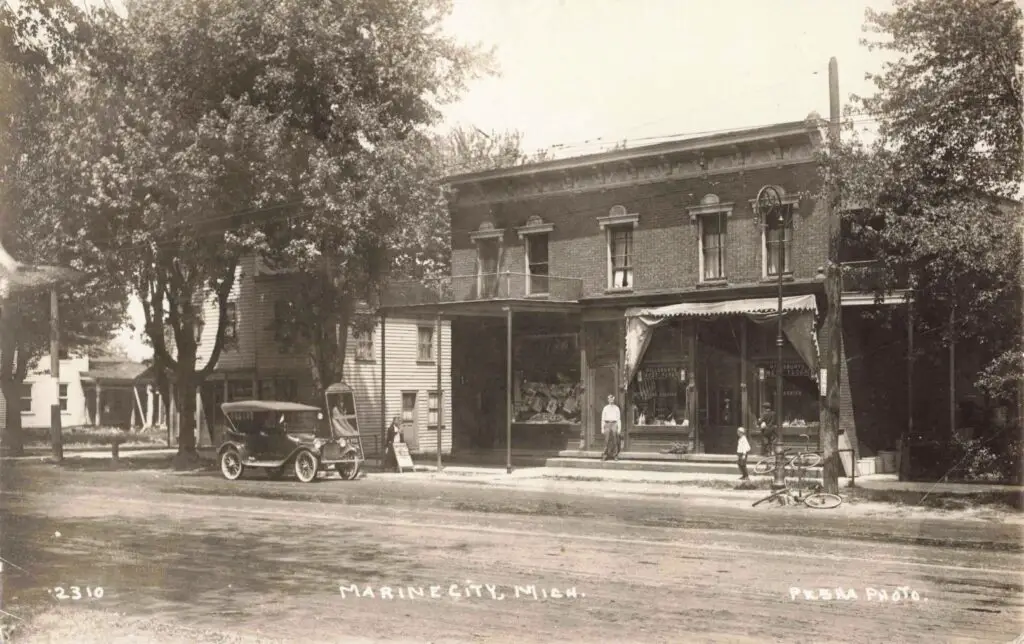
The Scott Brothers’ hardware was located on Main Street (Broadway) and was a thriving business circa 1900–1940. The store sold tools, building materials (including the concrete blocks pioneered by Will J. Scott), and household goods. It was known for its handsome brick storefront and large display windows. In later years, the Scott hardware store space evolved into Scott’s Pharmacy, which remained under the Scott family name until the mid-20th century. The building still exists as a commercial property downtown, retaining its original façade. It stands as a tangible reminder of Marine City’s historic family-run businesses and the enduring presence of its main street commerce.
Industrial Sites
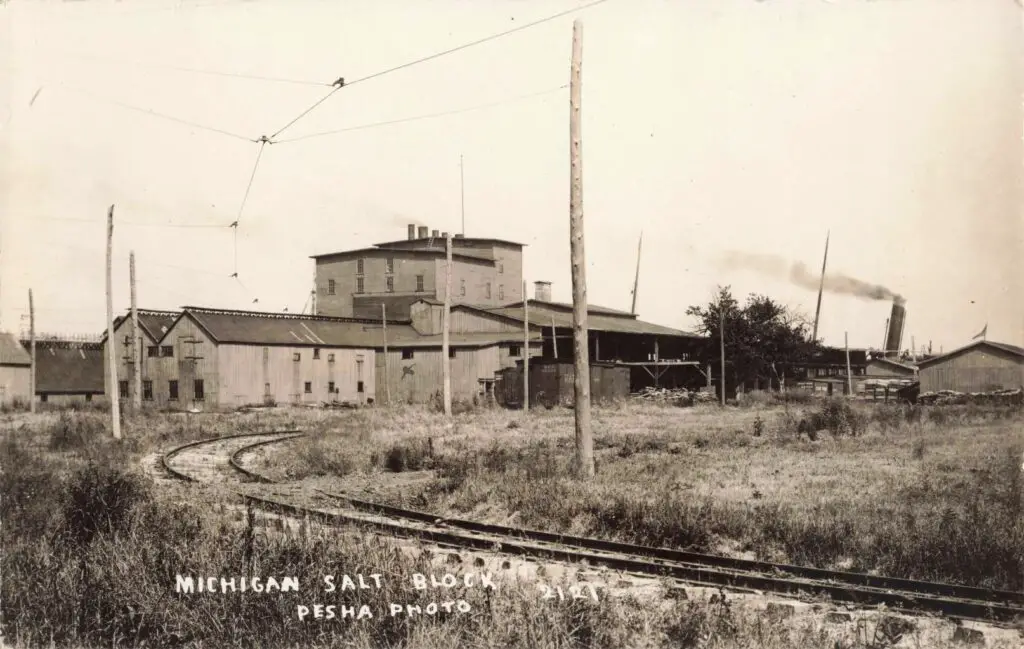
Some early industrial sites dotted the riverfront and outskirts. The Marine City Sugar Refinery (near the railroad tracks south of town) was a massive complex in 1901, with its brick crystallization house and tall chimney visible for miles. After it closed, the building was repurposed for other factories for a time, but eventually it was demolished in the mid-20th century; today, little remains at the site aside from foundations. The Salt Works along the Belle River operated into the early 1900s; its evaporators and storage sheds are long gone, but that area later became part of light industrial parks. The grain elevator by the river, with its unique concrete block construction, operated for many decades as the Marine City Farmers Co-Op Elevator. That elevator (or its successors) remained a landmark for grain shipping into the mid-1900s. It was eventually removed as shipping patterns changed, though a grain dock (“Seys Grain Elevator”) is still noted on navigation charts in Marine City. Finally, the old shipyard slips north of town, where wooden ships were once launched, have since been incorporated into the riverfront parkland and marina areas. The legacy of the shipyards is marked by historical signs and even a few artifacts (like anchor display pieces in a waterfront park), preserving the memory of Marine City’s maritime past.
In addition to these, Marine City had other notable sites such as the City Wharf and Ferry Dock, the Marine City Water Works (built 1885), which brought fresh water to town, and multiple schoolhouses (the old East Ward and West Ward schools). Many of the brick commercial blocks downtown date to the 1870s–1890s and still house boutiques and eateries today, giving modern Marine City an authentic 19th-century ambience.
Legacy and Preservation in Marine City Michigan
Marine City’s late 1800s industrial boom may have quieted by the mid-20th century, but the town retains a strong sense of its history. Comparisons between then and now highlight both continuity and change:
Economic Changes in Marine City Michigan
By the 1950s, the old industries – wooden shipbuilding, salt, sugar – had all ended or moved elsewhere. Marine City transitioned to a more typical small town economy, with residents working in light manufacturing or commuting to jobs in larger cities. The river trade continued but with steel freighters instead of schooners, and fewer locals directly employed on the ships. Today, Marine City has reinvented itself as a “vibrant tourist town” focused on arts, culture, and recreation. Boutique shops, museums, and waterfront eateries fill the downtown, attracting visitors who appreciate the historic charm.
Historic Preservation of Marine City’s Architrcture
Unlike some industrial towns that razed old structures, Marine City has preserved much of its historic architecture. Dozens of Victorian-era homes and storefronts survive, many of which have been lovingly restored. The 1880s City Hall remains a centerpiece and has been restored as a community gathering place (with discussions ongoing about reactivating its second-floor theater). Holy Cross Church still rings its bells for Mass every week, its Gothic architecture unchanged. The former Hotel DuPont/Colonial building stands, now housing apartments and a restaurant, maintaining its external appearance as it did in 1900. Walking down Water Street, one can spot plaques that note historic sites and the dates of buildings. Marine City’s pride in its past is evident in initiatives like the Pride & Heritage Museum (which displays ship models and local artifacts) and the outdoor Maritime Museum installations along the riverfront parks. These efforts ensure that the city’s “original charm” is not only preserved but also celebrated.
Adaptive Reuse of Buildings in Marine City Michigan
Many historic buildings have found new life with modern uses. For example, an old lumber mill warehouse has been converted into a theater venue, and a 19th-century bank building now hosts an antique shop. The Scott Brothers Hardware store building, as noted, became a pharmacy and now contains specialty retail. Such adaptive reuse preserves the structures while meeting current needs. Where demolition did occur (such as the sugar factory or certain factories), the sites have often been left as open space or redeveloped in modest ways, so the scale of the town remains human-sized and retains a historic feel.
Community and Culture in Marine City Michigan Today
The spirit of community that existed in 1900 persists in present-day Marine City. The descendants of old families still live in the area, and names like Ward, McElroy, and Scott appear in local directories and philanthropy. The town now boasts three live theaters and numerous festivals– interestingly echoing the entertainment offered by the old Opera House and river excursions, but updated for today. Events like maritime festivals, antique car shows, and holiday parades carry forward the tradition of communal celebration. Marine City’s schools, including Holy Cross, continue to be focal points, and new generations learn about their town’s history as part of their heritage.
Marine City’s late 19th to mid-20th century heyday established the layout and landmarks that define the town today. Its shipbuilding glory and industrial enterprises left an architectural and cultural imprint that has been carefully preserved. While the type of work and daily life have evolved – wooden ships and sugar beets giving way to tourism and the arts – Marine City remains proud of its past. The grain elevator, salt works, and mills may be gone, but the town’s identity as a historic riverfront community endures, anchored by iconic buildings like Holy Cross Church and City Hall, and by the collective memory of the people who labored, worshiped, and celebrated here over the decades. Marine City today is a place where the past and present converse: a restored Victorian streetscape bustling with modern boutiques, a former mariners’ town now welcoming new visitors, yet still looking out at the broad St. Clair River as it has for generations.
Through preservation and storytelling, Marine City ensures that the period from the late 1800s to 1950 is not lost to time, but lives on as a foundation for the community’s current revival – a true “small town with a big history.”
Sources for the History of Marine City
- Historical Society of Marine City – Marine City History Highlights
- St. Clair County Gazetteer (1888) – Development of Industries (Salt, Lumber, Marine)
- National Register of Historic Places Nomination – Marine City City Hall (1982)
- Detroit Catholic, Aug 2021 – “Holy Cross School Traces 150-Year History” (Church founded 1825, present church built 1903)
- Wikipedia – St. Clair River (Marine City as 19th-c. shipbuilding center)
- Michigan Exposures Blog – Holy Cross Church in Marine City (built by shipbuilder in 1903)
- C&G News (July 19, 2023) – “Discover Marine City” (overview of history and today’s Marine City)
- Beet Sugar Heritage Blog – Who Was Who in the Michigan Sugar Industry (Marine City Sugar Co. details)
- Detroit Historical Society – Louis J. Pesha Collection (Marine City photographer and river life)

